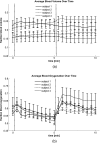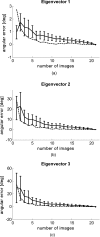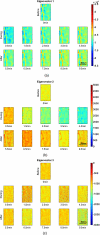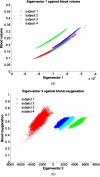Principal component model of multispectral data for near real-time skin chromophore mapping
- PMID: 20799809
- PMCID: PMC2929259
- DOI: 10.1117/1.3463010
Principal component model of multispectral data for near real-time skin chromophore mapping
Abstract
Multispectral images of skin contain information on the spatial distribution of biological chromophores, such as blood and melanin. From this, parameters such as blood volume and blood oxygenation can be retrieved using reconstruction algorithms. Most such approaches use some form of pixelwise or volumetric reconstruction code. We explore the use of principal component analysis (PCA) of multispectral images to access blood volume and blood oxygenation in near real time. We present data from healthy volunteers under arterial occlusion of the forearm, experiencing ischemia and reactive hyperemia. Using a two-layered analytical skin model, we show reconstruction results of blood volume and oxygenation and compare it to the results obtained from our new spectral analysis based on PCA. We demonstrate that PCA applied to multispectral images gives near equivalent results for skin chromophore mapping and quantification with the advantage of being three orders of magnitude faster than the reconstruction algorithm.
Figures










Similar articles
-
Quantitative principal component model for skin chromophore mapping using multi-spectral images and spatial priors.Biomed Opt Express. 2011 Apr 1;2(5):1040-58. doi: 10.1364/BOE.2.001040. Biomed Opt Express. 2011. PMID: 21559118 Free PMC article.
-
Lookup-table-based inverse model for human skin reflectance spectroscopy: two-layered Monte Carlo simulations and experiments.Opt Express. 2014 Jan 27;22(2):1852-64. doi: 10.1364/OE.22.001852. Opt Express. 2014. PMID: 24515194
-
Retinal blood oxygen saturation mapping by multispectral imaging and morphological angiography.Annu Int Conf IEEE Eng Med Biol Soc. 2007;2007:1627-30. doi: 10.1109/IEMBS.2007.4352618. Annu Int Conf IEEE Eng Med Biol Soc. 2007. PMID: 18002284
-
Journal of Clinical Monitoring and Computing 2015 end of year summary: tissue oxygenation and microcirculation.J Clin Monit Comput. 2016 Apr;30(2):141-6. doi: 10.1007/s10877-016-9846-4. Epub 2016 Feb 20. J Clin Monit Comput. 2016. PMID: 26897032 Free PMC article. Review.
-
Retinal oximetry and systemic arterial oxygen levels.Acta Ophthalmol. 2018 Nov;96 Suppl A113:1-44. doi: 10.1111/aos.13932. Acta Ophthalmol. 2018. PMID: 30460761 Review.
Cited by
-
Determination of tissue oxygen saturation by diffuse reflectance spectroscopy.J Biomed Opt. 2023 Sep;28(9):095002. doi: 10.1117/1.JBO.28.9.095002. Epub 2023 Sep 28. J Biomed Opt. 2023. PMID: 37780203 Free PMC article.
-
Single snapshot of optical properties image quality improvement using anisotropic two-dimensional windows filtering.J Biomed Opt. 2019 Mar;24(7):1-21. doi: 10.1117/1.JBO.24.7.071611. J Biomed Opt. 2019. PMID: 30927346 Free PMC article.
-
Analysis of skin morphological features and real-time monitoring using snapshot hyperspectral imaging.Biomed Opt Express. 2019 Oct 10;10(11):5625-5638. doi: 10.1364/BOE.10.005625. eCollection 2019 Nov 1. Biomed Opt Express. 2019. PMID: 31799035 Free PMC article.
-
Helical Nanostructures of Ferroelectric Liquid Crystals as Fast Phase Retarders for Spectral Information Extraction Devices: A Comparison with the Nematic Liquid Crystal Phase Retarders.Materials (Basel). 2021 Sep 24;14(19):5540. doi: 10.3390/ma14195540. Materials (Basel). 2021. PMID: 34639937 Free PMC article.
-
Quantitative principal component model for skin chromophore mapping using multi-spectral images and spatial priors.Biomed Opt Express. 2011 Apr 1;2(5):1040-58. doi: 10.1364/BOE.2.001040. Biomed Opt Express. 2011. PMID: 21559118 Free PMC article.
References
-
- Vogel A., Chernomordik V. V., Riley J. D., Hassan M., Amyot F., Dasgeb B., Demos S. G., Pursley R., Little R. F., Yarchoan R., Tao Y., and Gandjbakhche A. H., “Using noninvasive multispectral imaging to quantitatively assess tissue vasculature,” J. Biomed. Opt. JBOPFO 12(5), 051604 (2007).10.1117/1.2801718 - DOI - PMC - PubMed
Publication types
MeSH terms
Substances
Grants and funding
LinkOut - more resources
Full Text Sources
Other Literature Sources

